In a true case of “what’s old is new again” the last several years have seen not only a resurgence of the lever action rifle, but an evolution of it. Although this platform was once reserved for ranchers and cowboy action shooters, well-known companies like Midwest Industries have committed significant resources to developing accessories that modernize this oft-overshadowed platform. Smaller custom houses like Mad Pig Customs go even further, offering complete boutique tactical lever gun builds with selectable furniture, accessories, and colorways. With all this effort expended to teach an old gun new tricks, some of you are certainly wondering: why?
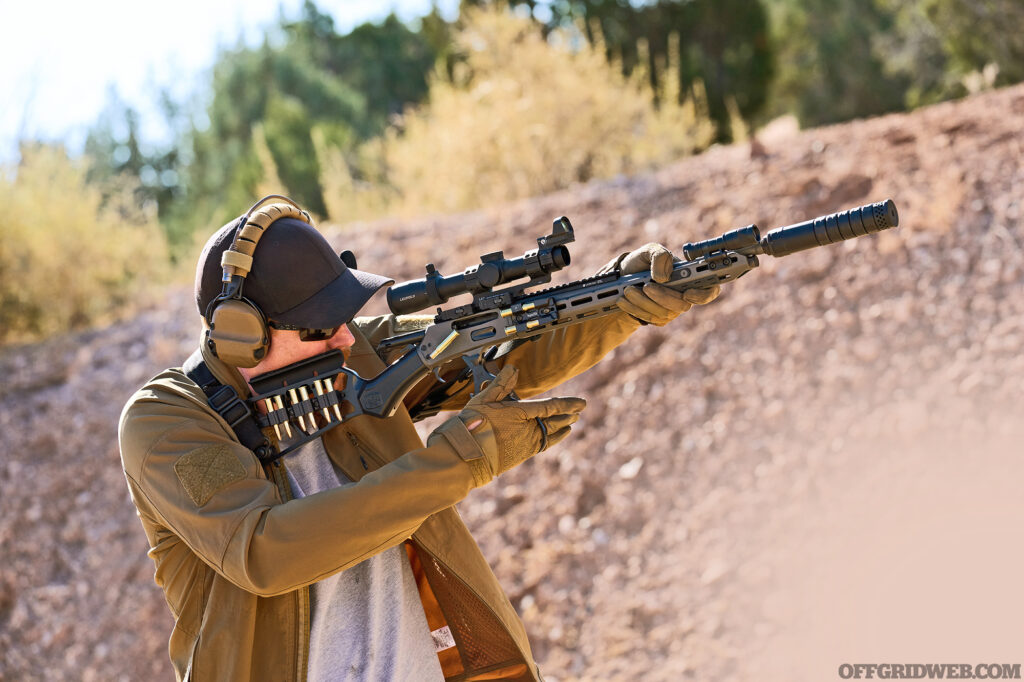
We’re not sure there’s a definitive answer. If all you care about is practicality and cost-effectiveness, it’s impossible to deny the advantages of a modern semi-auto rifle with a detachable 30-round magazine. But there are still some genuine merits to an updated lever gun, sometimes colloquially known as “the cowboy assault rifle.”
Speaking assault rifles, a rifle with a manually cycled action and tube magazine can skirt just about any assault weapon restriction in the country. You can forget about fin grips and put flash hiders back on the menu, even in places like California. For those who live in (or frequently travel through) freedom-restricted territory, a tactical lever gun might be a great way to get around draconian legislation while still having an accurate and heavy-hitting rifle with all manner of modern accessories.
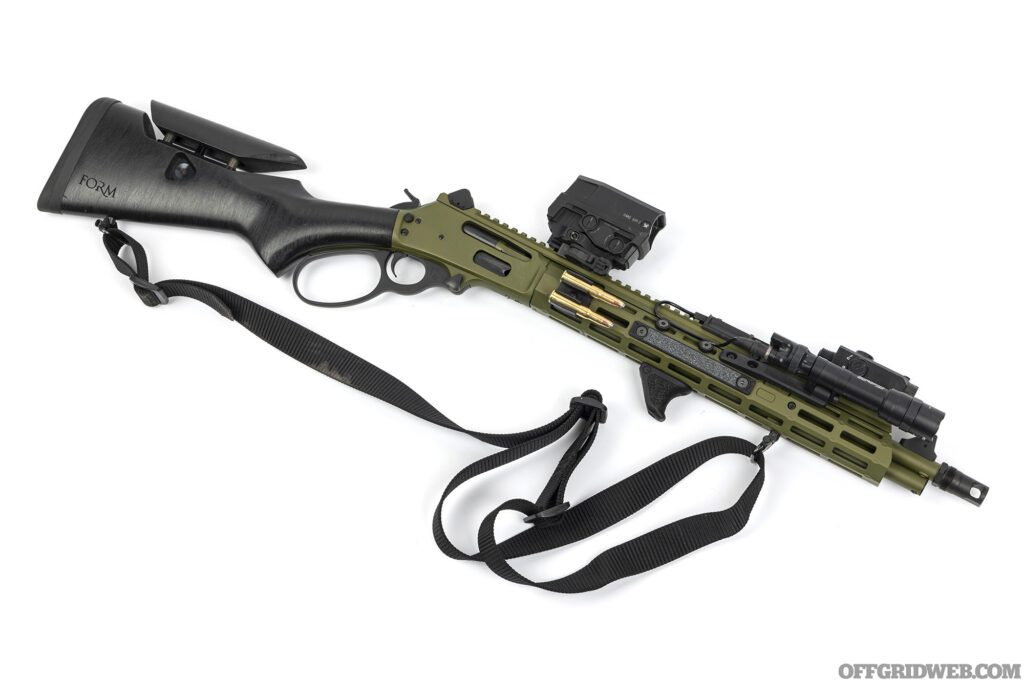
Above: Tom's rifle features a traditional sling from Wilderness Tactical attached to studs on the underside of the stock and handguard.
Caliber options are many, ranging from rimfire to the behemoth .45-70 that has a documented history of taking down most of the world’s biggest and toughest game — Marlin even jokingly advertised it as effective against a T-Rex. Both of the sample guns you’ll see in this article are in .30-30 Winchester, a highly respectable caliber in its own right for general preparedness. With bullet weights typically ranging from 150 to 170 grains and muzzle velocities around 2,000 feet per second, this caliber has been used on nearly every game animal on the North American continent from mule deer to black bear, elk, and moose.
This translates easily to use as a defensive caliber. While not known for its long-range capabilities, it's generally accepted as a 200-yard cartridge, which is right in line with most mass-issue military calibers. In fact, its trajectory and ballistic data is very similar to that of arguably the most widely used military caliber on the modern battlefield: 7.62x39mm Russian. While a lever gun lacks the capacity or rate of fire of an AK-type rifle, the .30-30 is in very good ballistic company when it comes to in extremis use in mixed terrain environments.
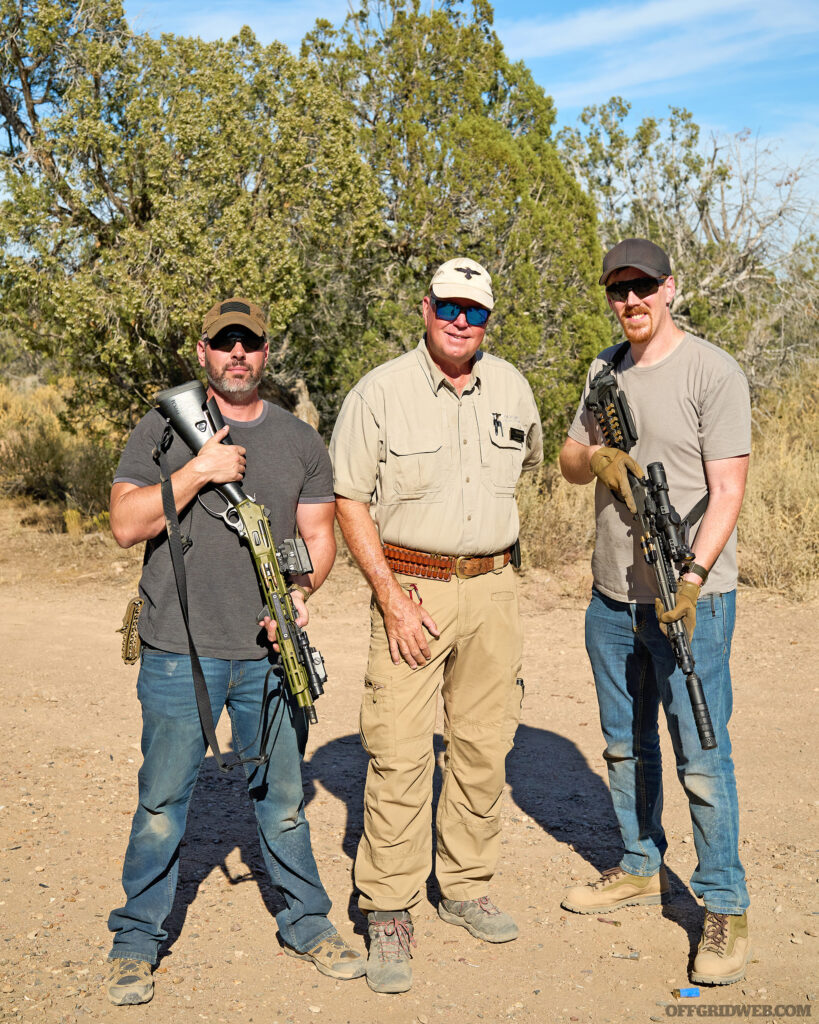
Above: During the class, Gunsite instructor Lew Gosnell imparted wisdom and coached us through a variety of drills to improve our lever gun skills.
Preparation is an intensely personal pursuit. Some folks have determined that they simply don’t require the capacity or fire rate of a modern semi-automatic carbine. But many of those same folks think it prudent to have a firearm of some kind around for the ever-ominous “just in case.” A lever-action rifle is easier to shoot than a pistol and reaches farther than a shotgun. But, until a few years ago, this choice meant sacrificing easy access to modern enhancements like suppressors, weapon lights, electronic optics, lasers, modular grips, or adjustable stocks. Those days are over, and we’re here to prove it.
We’re showcasing two separate rifles, both built by Mad Pig Customs, each with different furniture and accessories. Mad Pig refinished each rifle in our preferred Cerakote colors, installed their signature lever and trigger parts, and performed a complete action job to ensure smooth and reliable functionality. We hope to shed some light on the myriad possible configurations available with a modernized lever-action rifle and prove once and for all that this platform hasn’t been relegated to history books.
RECOIL Staff Editor Tom Marshall’s Setup
This rifle started life as a Marlin 30AW. No longer in production, the 30AW was meant as a more budget-friendly alternative to the flagship Marlin 336. With less expensive furniture material and less refinement in the fit and finish, the 30AW was truly a working man’s gun. The team at Mad Pig Customs stripped this rifle down to the skeleton and rebuilt it, starting with a Midwest Industries M-LOK handguard and a Form Stocks back end.
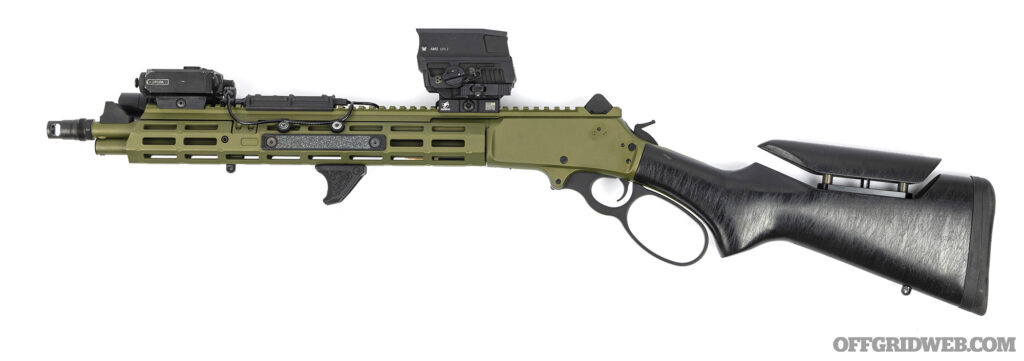
The MI handguard offers a full-length, seven-sided M-LOK surface with a continuous top rail. This allowed us to mount both a Vortex UH-1 holographic sight (on an ADM riser) as well as a Holosun LS-321G dual-beam laser/illuminator. Also from Midwest Industries are the universal shell caddies, which each hold a pair of .30-30 rounds. The Form stock retains a modicum of traditional styling with the upgrade of an adjustable-height comb, which comes in handy when using an optic riser.
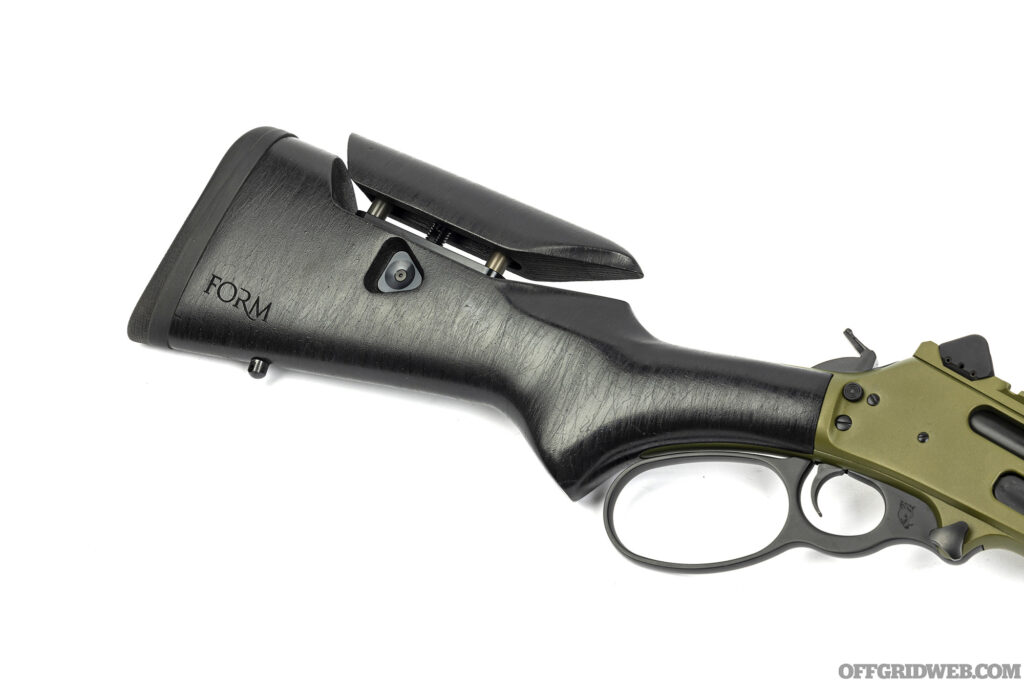
A SureFire Dual-Fuel Scout light gave us low-light ability, with a dual-lead remote switch to run both light and laser from one switch. A pair of Walker Defense NILE grip panels and an Emissary Development Handbrake Mini gave us a little customization for support hand control. Finally, a Langolis Rhodesian sling from Wilderness Tactical was mounted to the factory sling studs. The muzzle device is a Rearden Manufacturing brake that also features their suppressor mount.
RECOIL OFFGRID Editor Patrick McCarthy’s Setup
Unlike Tom’s rifle, this one has been a so-called “tactical” lever gun from day one. It started out as a Marlin 336 Dark Series, a special variant that was only available for a short time before Remington went bankrupt, ceased production of Marlin rifles, and sold the brand to Ruger. (Ruger recently announced the re-launch of the Marlin Dark Series, this time with a M-LOK forend and adjustable stock straight from the factory.)
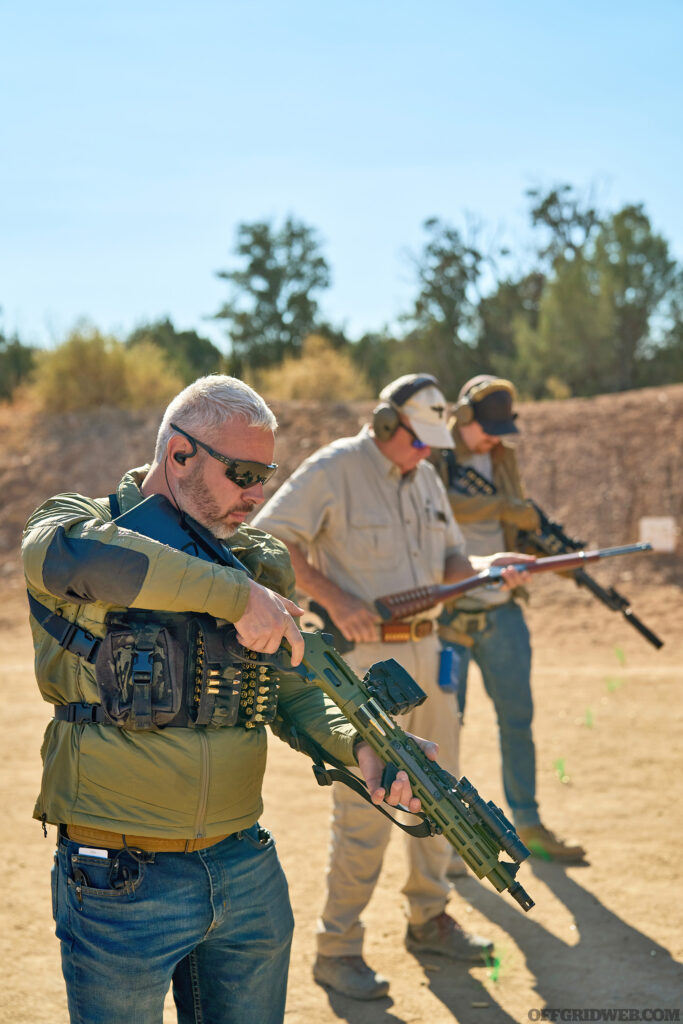
Above: A lever gun's manual of arms is somewhat comparable to that of a pump shotgun, but the half-cock safe position requires an additional learning curve.
Originally, the Dark Series came with a 16.25-inch threaded barrel, XS lever rail with ghost ring sight, and black-painted wood furniture. Mad Pig Customs replaced this rifle’s wood furniture with a machined aluminum stock from Chisel Machining and a LASAI handguard from Hoptic USA. The stock features a soft Kick-Eez recoil pad, adjustable cheek rest, QD sling socket, and an attachment point for a six-round Hoptic LongBow ammo carrier.
The handguard is equipped with a Hoptic USA Quiver carrying two more rounds of .30-30, a JMac Customs HRD handstop, a Burn Proof Gear heat-resistant rail wrap, and a SureFire Mini Scout Light Pro Infrared with selectable white or IR output. Atop the rifle’s original XS sight rail is a Leupold Patrol 6HD 1-6x24mm LPVO in a Midwest Industries 30mm QD scope mount; a Leupold DeltaPoint Pro NV red dot is mounted at the 12:00 position on a Reptilia ROF-SAR ring mount.

Above: The Burn Proof Gear Rail-Rap seen in these photos is our latest addition to the rifle. The suppressed barrel heats up quickly with rapid fire, and this offers protection for gloved or ungloved hands.
The magnified optic’s simple duplex reticle and illuminated FireDot are ideal for daytime shooting, and the top-mounted, NV-capable DeltaPoint pairs with the IR weapon light to make this rifle usable under night vision just like my favorite AR-15s. I topped off my rifle with a JK Armament suppressor attached to the threaded Rearden SPB muzzle brake via a Rearden Atlas adapter, and a Blue Force Gear Vickers padded sling.
Ammo Carriage Considerations
One of the downsides of lever guns is their tube magazines, which make their manual of arms more like that of a shotgun than a modern bolt-action or semi-auto. While we’ve already touched on the idiosyncrasies of reloading, this also affects ammo carriage and load bearing. You won’t be carrying a box magazine in a belt pouch, so you’re left with tossing a fistful of loose rounds in your pants pocket — a compromise that’ll inevitably lead to slow, fumbled reloads — or seeking specialized ammo carriage equipment that’s a little harder to source. We found two companies who offer lever-gun-specific ammo pouches.
Wilderness Tactical offers a simple, low-profile solution called the ZipLoader. This is the equivalent of wearing an ammo butt cuff on your belt. It’s a simple nylon platform with 10 elastic loops for individual cartridges. We paired this with a small, zippered Bug Pack, also from Wilderness Tactical, which was used to carry loose rounds to replenish our other ammo carriers between drills.
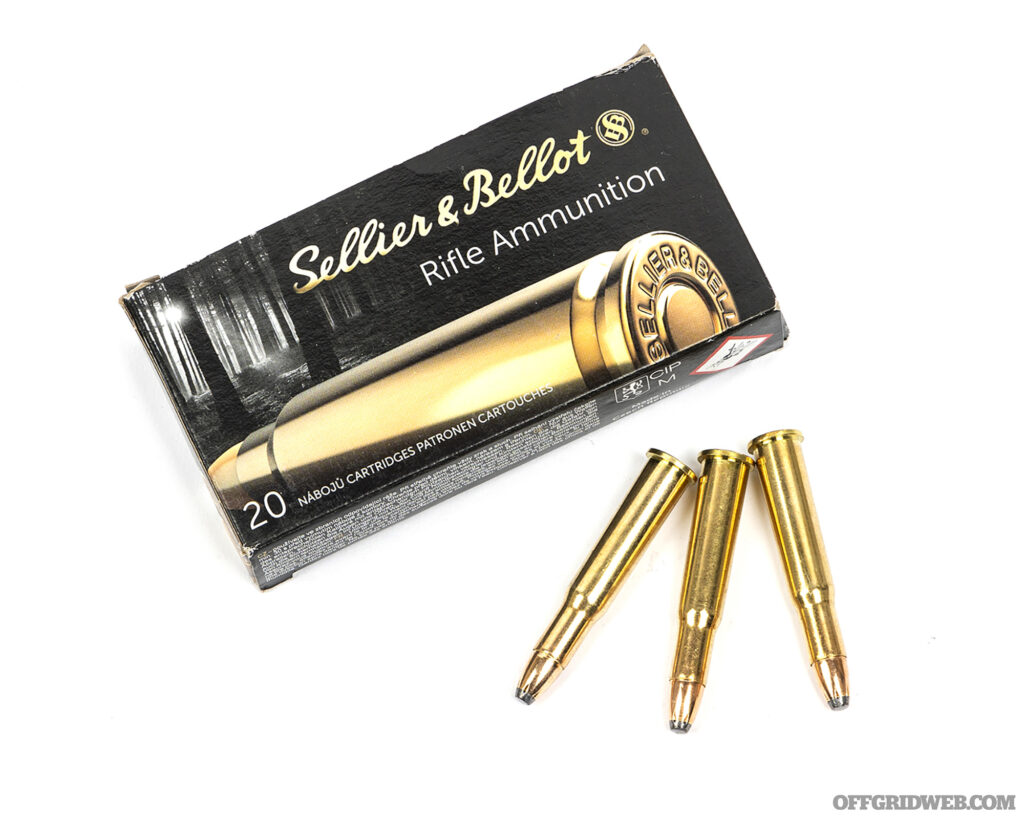
Above: Sellier & Bellot provided the 150-grain .30-30 ammunition we used during this lever gun class at Gunsite.
For those who want a larger supply of organized ammo storage, or more flexibility for carriage, Grim Hunter Tactical makes two products we had the chance to evaluate for this article. The first is their Quick Loader Pouch, a fold-out pouch that carries 24 rounds. There are eight loops hard sewn to the outside of the pouch. Inside the pouch are two more tear-away “cards” that hold another eight rounds each, which attach to the inside of the pouch by hook-and-loop.
We really like this modular design, as it allows you to attach those cards to other places you might want ammo — stick them to the headliner in your truck, the outside of your range bag, or even the sleeve of your combat shirt or jacket. The Quick Loader Pouch can be ordered with either MOLLE/PALS backing or a belt loop and is available in nearly two dozen colors.
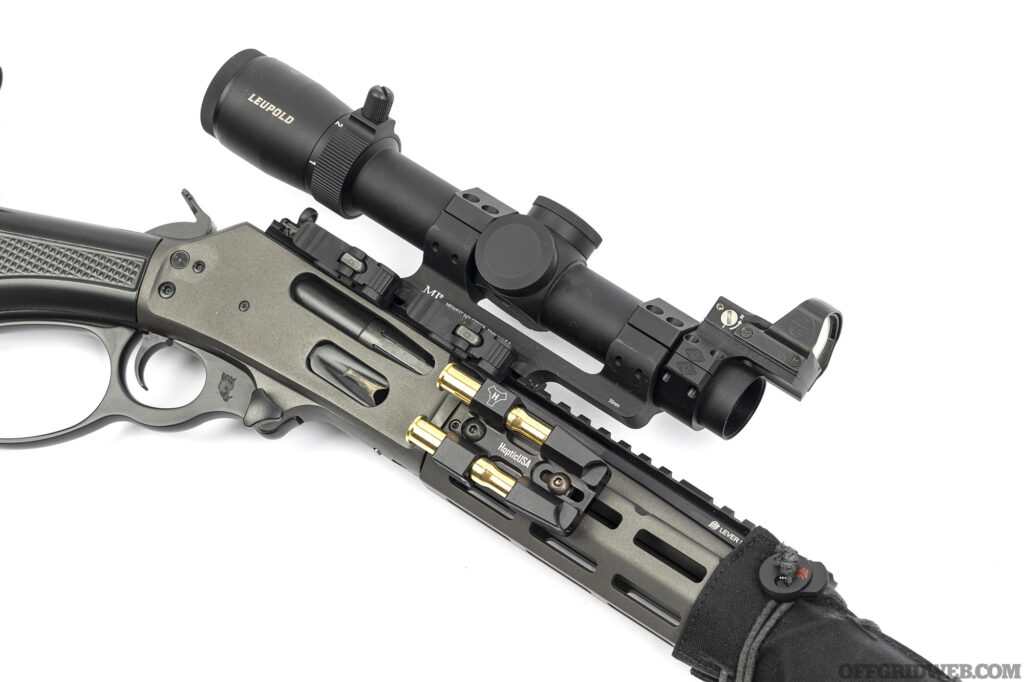
Above: The lightweight Patrol 6HD LPVO from Leupold provides plenty of magnification for precise shots, and the top-mounted DeltaPoint Pro NV is suitable for night vision use.
If your lever gun is your dedicated bugout or SHTF rifle, Grim Hunter offers a Lever Gun Chest Rig consisting of two Quick Loader Pouches and a third detachable pouch that can be used as a medical kit or admin pouch. On Grim Hunter’s website, you can choose to have your ammo pouches biased to the left or right side of the rig, based on personal preference. It’s available in a variety of colors with multiple harness options.
Finally, much like a shotgun, it may be advantageous to carry a few extra rounds on the gun itself for speed reloads. These can be carried on a traditional fabric or leather butt cuff or attached to modern M-LOK-mounted carriers such as those seen on our rifles.
While testing and training with our lever guns, we used Sellier & Bellot 150-grain soft-point .30-30 ammo.
Home on the Range at Gunsite
The effectiveness of any tool is contingent on its user’s skill and experience, and our lever-action rifles are no different. The two of us have spent quite a bit of time training with AR-15s, but AR-15s these ain’t. Many of the fundamentals carry over — stance, grip, sight picture, trigger control, and so on. However, the manual of arms is drastically different from an AR, in addition to the reloading and ammo management challenges we mentioned earlier.
This led us to seek training from Lew Gosnell, an instructor who has amassed a variety of vintage and modern lever-actions and spent many years teaching students about the intricacies of these rifles. Gosnell is a Marine Corps veteran who also spent 31 years working in law enforcement on the streets of East L.A. These days, he teaches Defensive Lever Gun and other courses at Gunsite Academy in Paulden, Arizona.
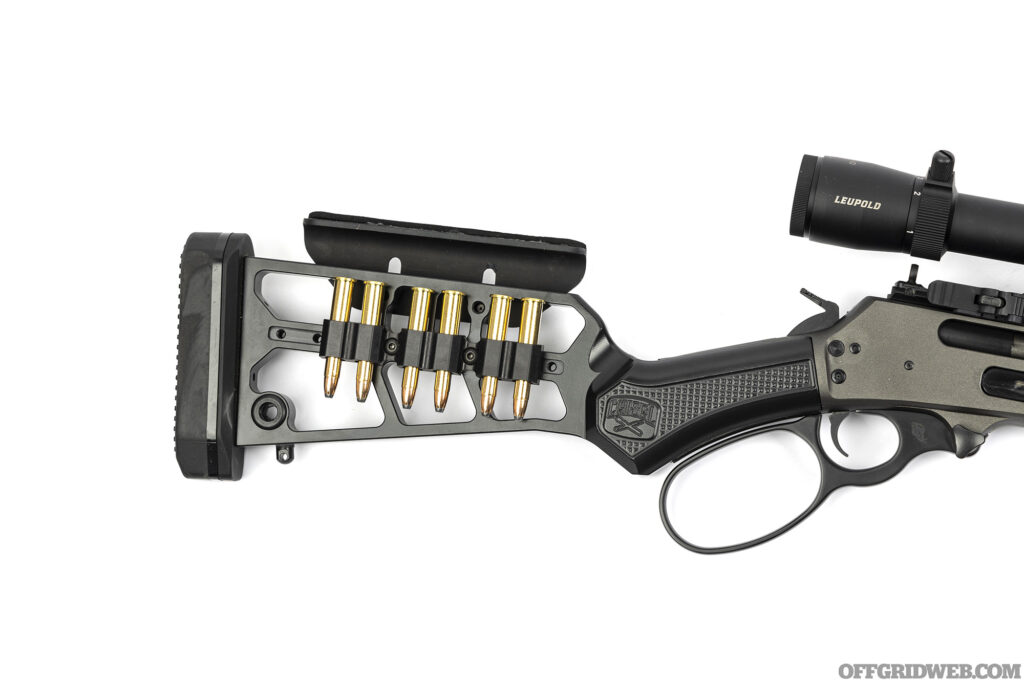
In case you’re not familiar with Gunsite, it’s considered by many to be the mecca of firearms training in the United States, if not the whole world. Founded in 1976 by Lt. Col. Jeff Cooper as a location at which to teach his Modern Technique of the Pistol, Gunsite has evolved into an expansive facility with a wide range of pistol, rifle, shotgun, and even edged weapon classes.
It offers everything from classrooms and traditional range bays to run-and-gun Simulator courses, complex shoot houses, and vehicle-based training areas. It’s like an amusement park for shooting enthusiasts, complete with catered lunches, an on-site campground, and a museum built inside Cooper’s home.
After traveling to Gunsite and meeting Gosnell, we headed out to the 50-yard Hanneken range to start working with our lever guns.
Half-Cocked
The first order of business was to learn about manipulating the lever gun’s safeties. Both of our Marlin rifles feature manual cross-bolt safeties — Marlin calls it a Hammer Block Safety — but this feature is a relatively recent addition introduced in the early 1980s. Gosnell and many other lever gun users view this manual safety as redundant and excessive. Historically, the primary safety on an exposed hammer lever gun was the half-cocked position, pulled back halfway to full cock.
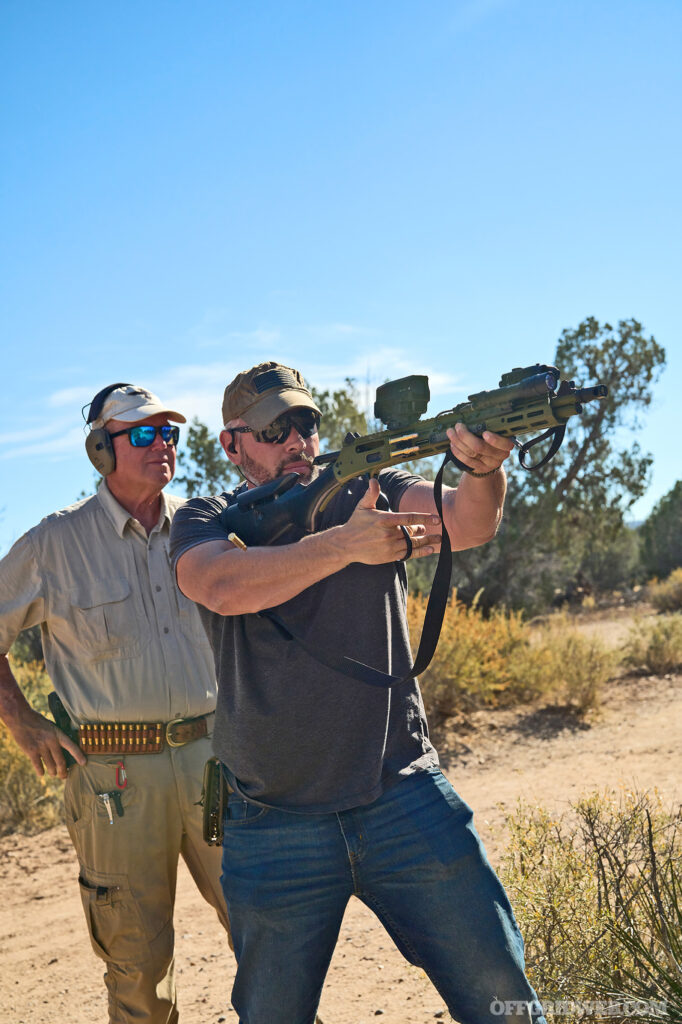
This prevented the hammer from resting against the firing pin, which could potentially fire a round if an object struck the hammer hard enough. It also prevented users from carrying the gun fully cocked and ready to fire at all times, which could lead to a negligent discharge if a foreign object touched the trigger.
To prepare our lever guns for a drill, we went through the following procedure:
- Half cock the hammer then engage the manual safety.
- Load the tube magazine.
- Cycle the lever to chamber a round. The hammer is now fully cocked. (Top off the tube magazine with one more round if necessary.)
- With the manual safety still engaged and the gun pointed in a safe direction, place the firing hand thumb on the fully cocked hammer and apply pressure.
- Maintaining firm pressure on the hammer, press the trigger just long enough to carefully lower the hammer into the half-cocked position.
- Index the trigger finger safely on the side of the receiver and disengage the manual safety.
As soon as Gosnell gave the command to fire, we quickly thumbed our hammers back to fully cocked position and pressed the trigger.
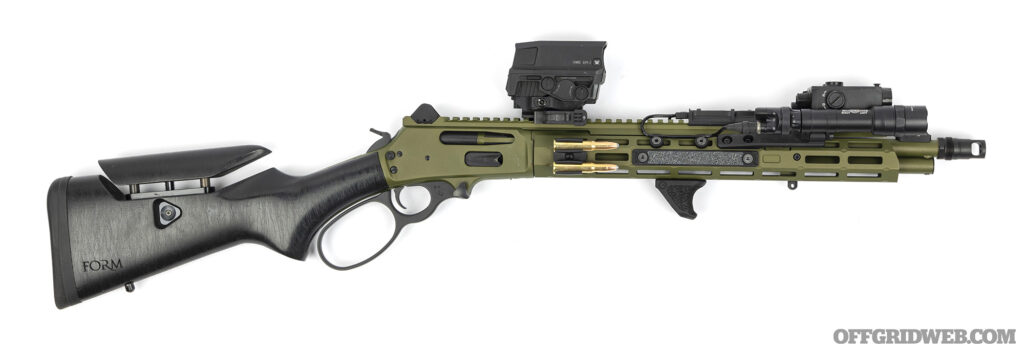
In a way, the manual safety serves as training wheels — if a shooter lets the hammer slip while returning it to half cock, it prevents the gun from firing. But once we had done enough dry and live fire reps of this process to be fully comfortable with it, we left the manual safety disengaged and carefully returned our guns to half cock after firing. Always be careful to maintain a good grip on the hammer while returning it to half cock; this isn’t something that should be rushed. As Gosnell explained, this procedure may feel strange to us today, but it was the standard modus operandi for more than a century before the introduction of cross-bolt safeties.
Feeding the Beast
Loading a lever gun is similar to loading a shotgun, but the placement of the loading gate on the right side of the receiver (as opposed to the underside) means you’ll have to load with your firing hand. Hold the gun in a low-ready position against the shoulder and press each round into the tube magazine until the loading gate closes behind it. Alternately, you can use a “violin load” position by resting the buttstock sideways over your shoulder, leaving the loading gate facing upward. Gosnell reminded us to keep our heads up and eyes downrange while loading to remain aware of potential threats.
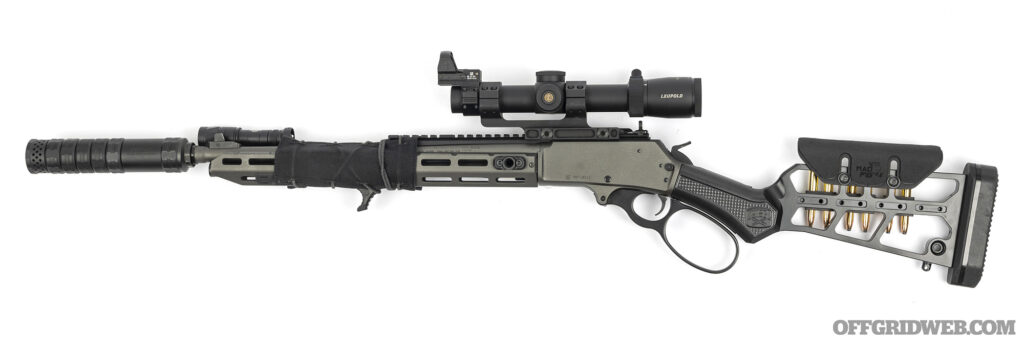
Also like a shotgun, it’s OK to load a round directly into the chamber while the action is open. This can be useful for speed reloads in conjunction with a match-saver-style ammo carrier directly in front of the ejection port (as seen on both our rifles). However, be aware that lever guns can have trouble feeding if they’re operated at steep angles. So, don’t try to chamber load — or operate the lever at all — with the muzzle pointed at the ground.
To run the lever, be quick and forceful but deliberate. Babying it or failing to run the lever all the way forward may induce a malfunction. We also found that the angle of hand movement is important. Depending on your rifle and lever design, you may need to push your hand down, forward, or somewhere in between to achieve the smoothest action.
Testing Our Skills
Once we were comfortable manipulating, loading, and firing our lever guns on the 50-yard range, we moved on to more complex challenges. After all, that manual of arms may feel comfortable on a flat range, but doing it while running, transitioning between multiple targets, and navigating around obstacles is a different story. This wasn’t just a lever gun class — it was a defensive lever gun class.
We started by setting up a barricade on the range, leaning out from either side to shoot without exposing ourselves more than necessary. Then, we ratcheted up a notch by heading down to The Pit, an indoor Simulator course that most of us would call a shoot house. We practiced clearing the structure, “slicing the pie” around doorways and corners to methodically take in every angle before proceeding.
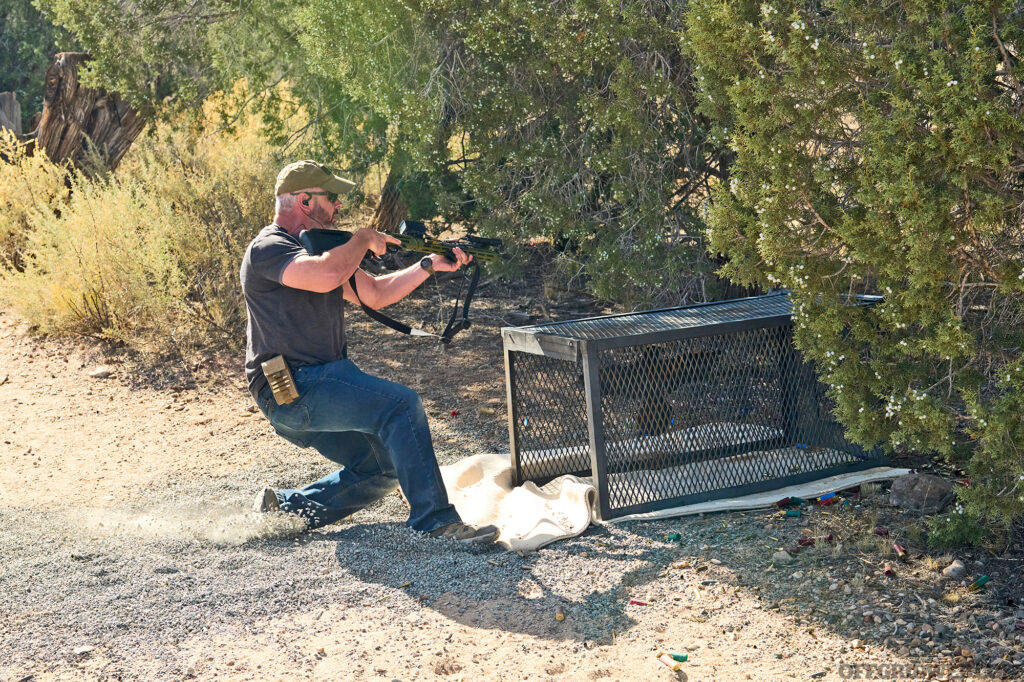
Above: Tom Marshall slides into a shooting position.
Admittedly, we’d prefer a semi-auto rifle over a lever gun for these close-quarters applications, since thumbing back the hammer before firing and running the action between shots was tougher than just mashing a trigger. That said, our Mad Pig Marlins had no trouble getting repeatable, accurate hits on the threats in hallways, corners, and windows. The tall-mounted red-dot optics on both rifles were helpful for this purpose, offering a wide field of view and fast sight acquisition.
Next, we headed to Gunsite’s Military Crest, a winding trail with various natural shooting positions and an array of steel targets at distances of 100 to 200 yards or greater. We braced off trees and rocks, and used our rifles in standing, kneeling, and sitting positions. With a slight hold-over for the longer shots, we had no trouble ringing steel from each position. The only challenge we encountered was running the lever in positions where the rifle was rested on a flat surface, such as kneeling behind a stump; it may be necessary to lift or rotate the rifle to make room to move the lever. This is also why lever guns aren’t ideal for prone shooting.
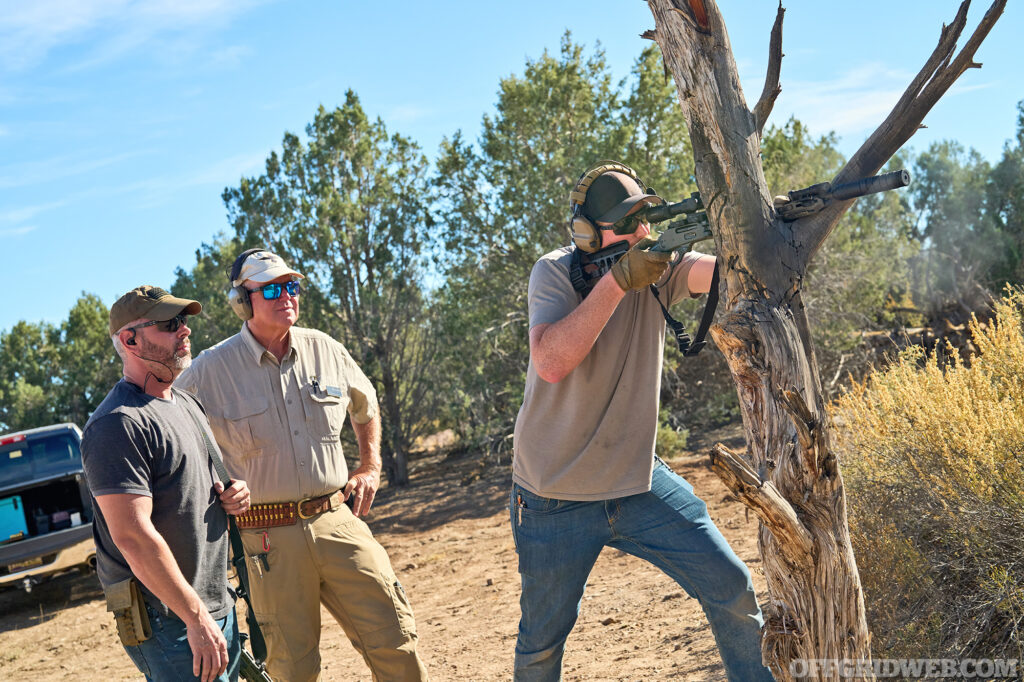
Above: Whether you're a fan of modern “tactical” lever guns or you prefer wood furniture and iron sights, get out there and train. It's the only way to build lasting proficiency.
For our final challenge, we moved to the Scrambler, a course that continued our work on positional shooting but added an emphasis on speed. With four rounds in our guns and a shot timer running, we sprinted between seven positions and shot steel targets while standing, kneeling, and sitting. Some stations had fallen logs or trees to use for support, but others required unsupported shots. This also tested our ability to load our rifles quickly while moving, and to carefully engage the half-cocked position after each hit — just like any other move-and-shoot drill, it’s essential to make your weapon safe before running ahead with it. By the end of the Scrambler, we were out of breath and grinning.
Final Thoughts
So, the question remains: Is it worth the effort to teach an old gun new tricks? Based on our experience with these two builds and our range time at Gunsite, we’d give an emphatic yes. While we certainly won’t deny there are more efficient, ergonomic, and cost-effective defensive weapons on the market, that doesn’t mean the venerable lever gun isn’t worth owning. And if it’s worth owning, it’s worth modifying and improving with aftermarket parts, just like your favorite semi-auto carbine.
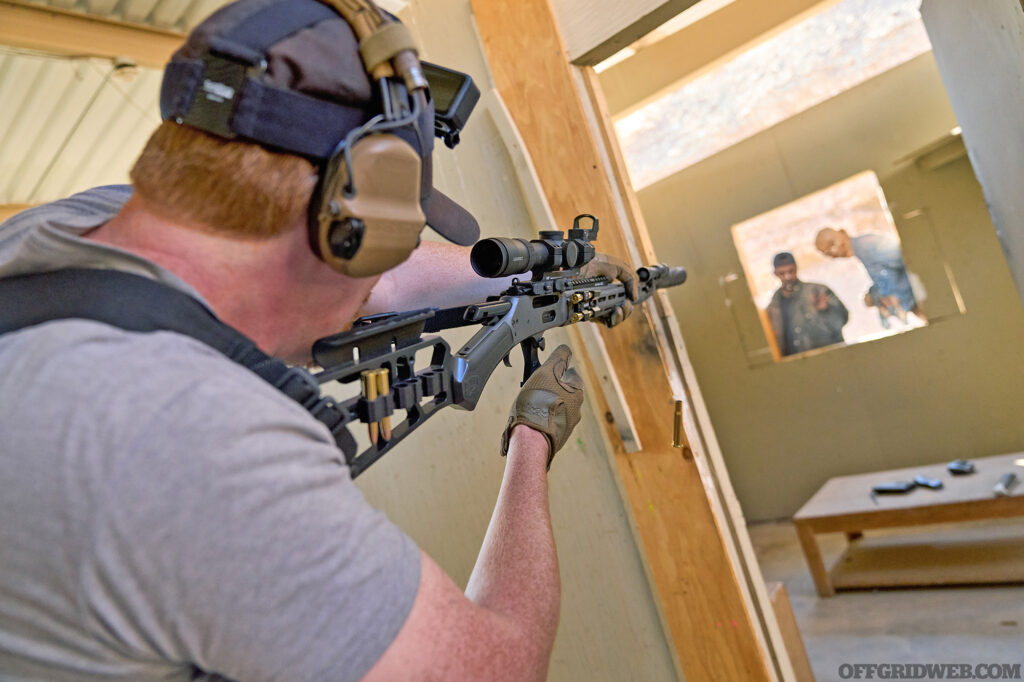
Above: Some may scoff at the idea of using a lever-action for home defense and CQB, but in states and countries where semi-automatic rifles are heavily restricted, it may be one of the best options available.
These two modernized lever guns were built to deliberately push the envelope and become as AR-like (or “tactical,” if you prefer that term) as possible. They’re unabashedly extreme, like classic muscle cars converted into fire-breathing supercharged dragsters. You may not want a full M-LOK forend and adjustable stock for your lever gun, much less an infrared laser and night-vision-height optic mount, and that’s OK. Our intent was to show what’s possible using existing off-the-shelf components and a little fine-tuning in the hands of lever gun specialists at Mad Pig Customs. The result is a pair of rifles that never fail to stir up controversy on social media or draw a crowd at the local range. More importantly, they’re much more capable for dynamic shooting and defensive use than they were in unmodified form. Sorry, grandpa, you may not like it, but the future is now.
Sources
Read More
Subscribe to Recoil Offgrid's free newsletter for more content like this.
Editor's Note: This article has been modified from its original print version for the web.
The post Pushing the Boundaries of the Tactical Lever Gun appeared first on RECOIL OFFGRID.
By: Patrick Diedrich
Title: Pushing the Boundaries of the Tactical Lever Gun
Sourced From: www.offgridweb.com/preparation/pushing-the-boundaries-of-the-tactical-lever-gun/
Published Date: Mon, 08 Apr 2024 12:53:17 +0000
------------------------
Did you miss our previous article...
https://bushcrafttips.com/bushcraft-news/nvgs-togo-otte-gears-v2-og-helmet-bag
 What is BushcraftSurvival SkillsToolsVideosBushcraft CampsBushcraft KitsBushcraft ProjectsPrivacy PolicyTerms And Conditions
What is BushcraftSurvival SkillsToolsVideosBushcraft CampsBushcraft KitsBushcraft ProjectsPrivacy PolicyTerms And Conditions
